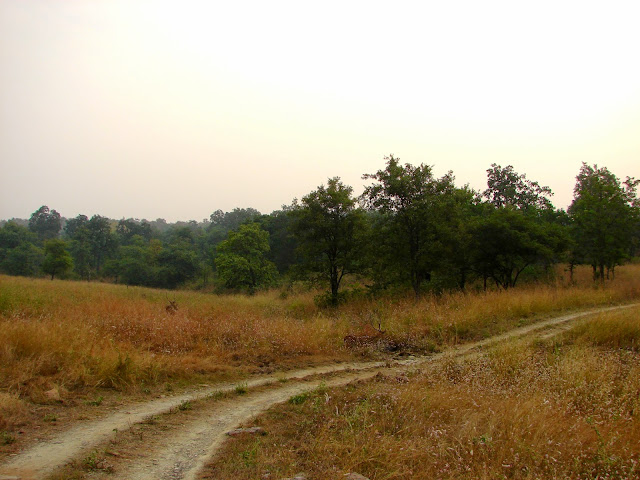 |
| Lake, seen from a viewpoint |
The Ken Gharial Sanctuary is located at the confluence of the Ken and Khuddar rivers in the Chattarpur district of Madhya Pradesh. This is one of the 4 main Ghariyal (the long-snouted crocodile) sanctuaries of India, The National Chambal Sanctuary being the largest one. Gharials are the last survivors of the Gavialidae class and are found in the Indian subcontinent only. Due to habitat loss, the decline in fish production, and poaching for skin they are on the verge of extinction and are listed as the critically endangered species of the world. They are a riverine keystone species and important for the balance of the freshwater system since they bring the river nutrients to the surface and help in the primary production of fish. *A keystone species is a plant or animal that plays a unique and crucial role in the way the ecosystem functions. Without keystone species, the ecosystem would be dramatically different or cease to exist altogether." (source: internet)
 |
In monsoons, this canyon is partly underwater
|
The sanctuary has restricted access because of an accident a couple of years back. A group of students at the waterfall didn't get enough time to come back to safe grounds when water was released from the barrage next to the sanctuary. After the tragic accident, visitors are not allowed to go near the waterfall. There were also reports of crocodile and gharial attacks on visitors bathing at the waterfall.
Ken Gharial Sanctuary can be accessed from Khajuraho (24 km away) and from the Panna Tiger Reserve. Autos, taxis, and motorbikes can be hired at Khajuraho. An autorickshaw or a tuk-tuk charges around Rs. 600 for a round trip from Khajuraho. Taxis will charge a little more and bikes will charge a little less. If one can bargain well, the fare can come down to Rs. 500. I shy away from haggling but in India, one must master the art of bargaining. It saves a lot, especially for a backpacker, even a teeny bit is huge.
 |
| Raneh Falls |
The sanctuary is located in a deep canyon possibly formed by volcanic activities millions of years back. The deep green water of the lake amidst the layered light and dark igneous rocks make the place absolutely picturesque. Though the larger waterfall was hardly visible from where we stood, the little that we could be no less appealing. We went there in late November, hence the water in the lakes and canyons was scanty but photos displayed at the visitor information desk suggested in monsoons, that this place has an entirely different look. Water fills up the canyon up to the level where we were standing then, at least 100 mts up. I can just imagine the raging waters engulfing the entire region.
Since the place borders the Panna National Forest, visitors can see animals and birds as well. At least sambars, chinkaras (Indian gazelle), chitals (spotted deer), nilgais (blue bull), langurs, and jackals can be easily sighted if visiting early morning or towards the evening.
But the sad part is because of the limited access to the base of the waterfalls gharial and crocodile sighting is rare. One can try using a guide's binoculars but again luck has to shine upon you. I have been one of those unlucky ones who never saw a tiger in a tiger sanctuary, a lion in a lion sanctuary, an orangutan in an orangutan sanctuary, or a gharial in a gharial sanctuary. Well, a zoo or a reserve has been my best bet so far, unfortunately. But I haven't given up hope as yet. Someday I might just get lucky.
Well, animal sighting or not, a few hours at this place wouldn't be a waste. It's beautiful.












